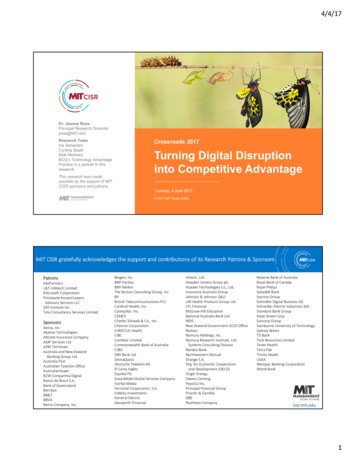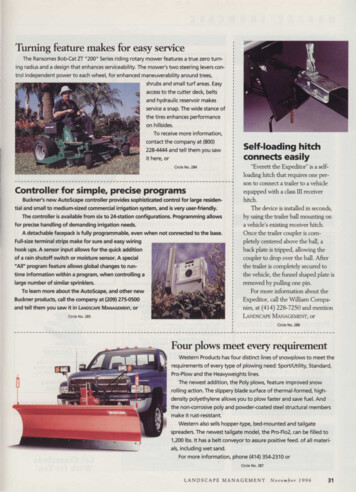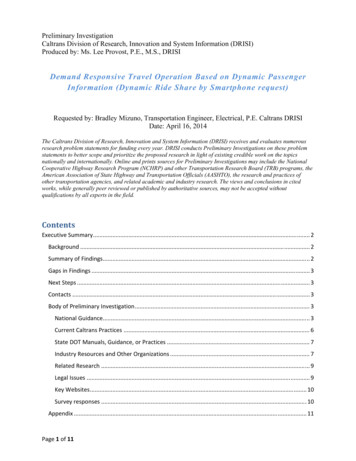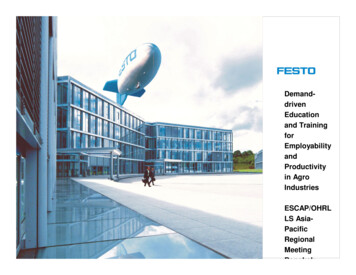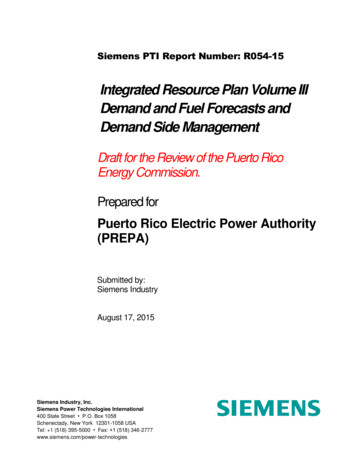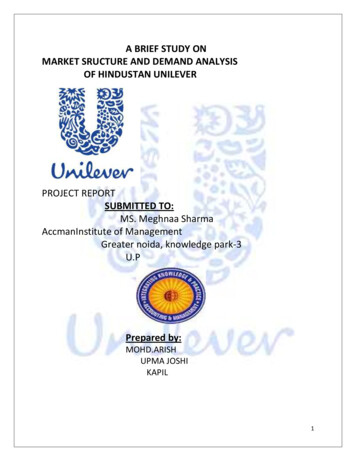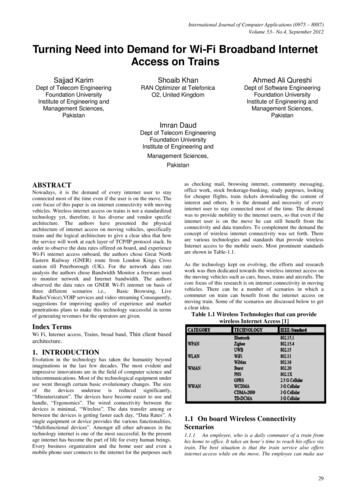
Transcription
International Journal of Computer Applications (0975 – 8887)Volume 53– No.4, September 2012Turning Need into Demand for Wi-Fi Broadband InternetAccess on TrainsSajjad KarimShoaib KhanAhmed Ali QureshiDept of Telecom EngineeringFoundation UniversityInstitute of Engineering andManagement Sciences,PakistanRAN Optimizer at TelefonicaO2, United KingdomDept of Software EngineeringFoundation UniversityInstitute of Engineering andManagement Sciences,PakistanImran DaudDept of Telecom EngineeringFoundation UniversityInstitute of Engineering andManagement Sciences,PakistanABSTRACTNowadays, it is the demand of every internet user to stayconnected most of the time even if the user is on the move. Thecore focus of this paper is on internet connectivity with movingvehicles. Wireless internet access on trains is not a standardizedtechnology yet, therefore, it has diverse and vendor specificarchitecture. The authors have presented the physicalarchitecture of internet access on moving vehicles, specificallytrains and the logical architecture to give a clear idea that howthe service will work at each layer of TCP/IP protocol stack. Inorder to observe the data rates offered on board, and experienceWi-Fi internet access onboard, the authors chose Great NorthEastern Railway (GNER) route from London Kings Crossstation till Peterborough (UK). For the network data rateanalysis the authors chose Bandwidth Monitor a freeware usedto monitor network and Internet bandwidth. The authorsobserved the data rates on GNER Wi-Fi internet on basis ofthree different scenarios i.e.,Basic Browsing, LiveRadio(Voice),VOIP services and video streaming Consequently,suggestions for improving quality of experience and marketpenetrations plans to make this technology successful in termsof generating revenues for the operators are given.Index Termsas checking mail, browsing internet, community messaging,office work, stock brokerage-banking, study purposes, lookingfor cheaper flights, train tickets downloading the content ofinterest and others. It is the demand and necessity of everyinternet user to stay connected most of the time. The demandwas to provide mobility to the internet users, so that even if theinternet user is on the move he can still benefit from theconnectivity and data transfers. To complement the demand theconcept of wireless internet connectivity was set forth. Thereare various technologies and standards that provide wirelessInternet access to the mobile users. Most prominent standardsare shown in Table-1.1.As the technology kept on evolving, the efforts and researchwork was then dedicated towards the wireless internet access onthe moving vehicles such as cars, buses, trains and aircrafts. Thecore focus of this research is on internet connectivity in movingvehicles. There can be a number of scenarios in which acommuter on train can benefit from the internet access onmoving train. Some of the scenarios are discussed below to geta clear idea.Table 1.1 Wireless Technologies that can providewireless Internet Access [1]Wi Fi, Internet access, Trains, broad band, Thin client basedarchitecture.1. INTRODUCTIONEvolution in the technology has taken the humanity beyondimaginations in the last few decades. The most evident andimpressive innovations are in the field of computer science andtelecommunications. Most of the technological equipment underuse went through certain basic evolutionary changes. The sizeof the devices underuse is reduced significantly,“Miniaturization”. The devices have become easier to use andhandle, “Ergonomics”. The wired connectivity between thedevices is minimal, “Wireless”. The data transfer among orbetween the devices is getting faster each day, “Data Rates”. Asingle equipment or device provides the various functionalities,“Multifunctional devices”. Amongst all other advances in thetechnology internet is one of the most successful. In the presentage internet has become the part of life for every human beings.Every business organization and the home user and even amobile phone user connects to the internet for the purposes such1.1 On board Wireless ConnectivityScenarios1.1.1 An employee, who is a daily commuter of a train fromhis home to office. It takes an hour’s time to reach his office viatrain. The best situation is that the train service also offersinternet access while on the move. The employee can make use29
International Journal of Computer Applications (0975 – 8887)Volume 53– No.4, September 2012of this service to start his office work rite at the moment whenhe grabs his seat in the train. Setting up his appointments andreplying to the official mails.1.1.2 A student commuting on train in a journey towards hisuniversity can check his student mail, class schedule and cancomplete his unfinished assignment on his journey.1.1.3 A stockbroker can be updated all the time with the upsand downs in the stock rates during his journey. He can bid fora new share or sell his current share without suffering from anydelays.1.1.4 A bored commuter who has to undergo a long journeycan watch a movie or listen to some good quality music duringhis journey. In case he likes to read books he can go to a webpage where he can find some useful material.1.1.5 A tourist can find the nearest taxi stand, and places tovisit near a particular station that he intends to visit. There canbe a never-ending list of scenarios, which clearly highlights thesignificance of Internet access while on the move.1.2 Key concerns towards Quality ofExperience (QoE)In the best case if the service is provided with the best availabletechnology availability and data rates all the commuters will besatisfied and the technology will be successful. Butunfortunately providing internet access on a high speed train isvery difficult. It is difficult to provide consistent andsatisfactory services. Further the authors have discussedarchitecture, technological aspects and best practices in detail.The key concerns towards the QoE are as follows.1. Is the commuter getting the data rates at which hiscommunication is meaningful?2. Are there any no-service areas or disconnect points during thejourney?3. Is the commuter satisfied with the service provided?4. Is there any room for enhancement in data rate andavailability?5. Is the communication on wireless link secure?6. Is the information provided on the web pages is current andupdated?7. Does the surfing offer minimal delays so that the commuter isnot annoyed?8. What is the pricing for the service? Is the commuter satisfiedwith the service and is willing to pay for it?9. What is the extra value added in service, to make the servicebetter as compared to other onboard internet providers?There are many Train services across the world that is providingdata services on the move, not only the trains but also someshipping companies and road-travelling companies are alsoproviding Internet services on the move as well. Some of theleading examples are Virgin Trains cover long distance railwayservices in U.K with Wi-Fi internet access, QinetiQ has derivedfull trails of Wi-Fi internet access of five major train routesacross Europe. But still this technology has not become abreakthrough in the industry yet. The authors have focused onthe reasons and strategies towards successful solutions later inthe paper.2. DIVERISTY IN PHYSICALARCHITECTUREWireless internet access on trains is not a standardizedtechnology yet, therefore, it has diverse and vendor specificarchitecture. The architectural components and technology isentirely based on service provider or service operator’s choice.However, the basic architectural components and technologicalsolutions available are discussed in detail. The vendor specificsolutions and protocol specific details will be discussed later. Tounderstand the overall architecture following two basic wirelessenvironments, working coherently to provide a single service,were kept in focus.1. A Wi-Fi onboard connectivity. In which each wirelessterminal user is connected to the onboard access point directlyusing his Wi-Fi 802.11a/b/g enabled equipment, it may be alaptop or PDA.2. A hybrid or technology specific antenna mounted on the trainroof to achieve wireless internet connectivity through sometechnological solution. The on-roof antenna may connectthrough WiMAX, GPRS, satellite or broadband power line.The passenger sitting on train is equipped with a TerminalEquipment (TE) that might be a Wi-Fi enabled laptop or PDA.The TE has a wireless connection with the Access Point (AP) ontrain. The AP is connected to the Rail Point server (RPS). Theauthentication and authorization checks for the passenger aredone at the RPS.Figure 2.0 External Wireless Link Diversity for train roof antenna30
International Journal of Computer Applications (0975 – 8887)Volume 53– No.4, September 2012The RPS on train connects to the Rail Point Gateway RPG onthe ground employing one of the wireless wide area networklinks such as Wi-Fi hotspot links, cellular links, GPRS, CDMA,WCDMA, WiMAX broadband access, 2-way, 1-way satellitelink, bi-directional antenna arrays or broadband on power linesas shown graphically in Figure-2.0.The decision for the specific technology of RPS to RPGconnection can be made on following points.1. The cost of deployment of a particular technology, CAPEX.2. The cost of link establishments and operating cost OPEX.3. Requirement of minimum data rate of the link, bandwidthrequirements.4. Requirement of availability of service in urban as well asrural areas.5. Quality of service and quality of experience requirements.railway track of 16 miles between San Francisco and San Jose.Caltrain provides internet access inside the train using highspeed broadband access technology, WiMAX that providescontinuous high speed Internet access along a rail line at travelspeeds of up to 79 miles per hour [2]Each technological solution has its strengths and weaknessesdepending on the scenario; thus, every technology can bebeneficial. But none of them can be called an ultimate solution.The authors have established technical details for each of theavailable choices for rail to ground link.2.1 Wi-Fi Based ConnectivityWi-Fi stands for Wireless Fidelity, it is IEEE 802.11 standardfor wireless connectivity between devices. It operates on 2.4GHz and 5 GHz ISM band. Most popular and commercial Wi-Fistandards are 802.11a/b/g. Currently used commercial productsare based on 802.1g standard that is backwards compatible. Themax range of Wi-Fi based link is 50 meters indoor and 150meters outdoor. The extended wireless link may range up to 300meters. But Wi-Fi based link offers data rates of 11 to 54 Mbps.Since the Wi-Fi based solution offers very low mobility itcannot be accepted as a solution for out of train connectivity.But onboard this is the best solution, while the passenger isinside the train. And the same technology can be used for RPSto RPG connectivity while the train is inside the station or atplatform. Thisway the authors will also be able to make most of the stations asWi-Fi hotspots. Similarly, while the train is passing through atunnel or a bridged area where there is no other service possible.For example the tunnel between Malmo Sweden andCopenhagen Denmark is almost 18 miles long and 12 milesunder water. In this situation Wi-Fi based access may be auseful solution.2.2 WiMAX based ConnectivityWiMAX stands for Worldwide Interoperability for MicrowaveAccess. It is based on IEEE 802.16 standard for interoperability.WiMAX can be considered as a long-range connectivity forbroadband services like telephony, data services, streamingmedia broadcast etc. WiMAX provides Metropolitan AreaNetwork (MAN) connectivity. WiMAX operates at 2 to 66 GHzfrequency range. This is a very high frequency and lowbandwidth spectrum, and more susceptible to noise. WiMAXoffers data rates up to 72Mbps and provides coverage up to 6miles or 10 kilometers. WiMAX is said to be the future ofBroadband Wireless Access (BWA) technology. There aremany other standards similar to WiMAX for long range MANbroadband access like HIPERMAN, WiBro and iBurst.Although WiMAX seems to be a better solution since it offershigh data rates along with a considerable range as depicted inFigure-2.2. But the problem is the cost of deployment ofWiMAX radio base stations along hundreds of miles of railroadtracks. The core advantage using WiMAX is its data rate, 72Mbps data rate is a very high and desired by every operator.Caltrain is the name of train service in USA working on theFigure 2.2 Visual difference between Wi-Fi andWiMAX coverage area2.3 Terrestrial Cellular based ConnectivityCellular based mobile technologies are the oldest commercialtechnologies that provide wireless data access to the devices.Cellular based connectivity can be based on either of thetechnologies like GPRS, EDGE, CDMA, WCDMA, TDDCDMA, and UMTS. The details of data rates offered andmaximum ranges are given in the Table-2.3.The table clearly shows the strengths and weaknesses of cellularterrestrial internet providers. The data rates provided by all theabove mentioned technologies have comparatively low serviceslike file transfers, streaming media and fast browsing is notpossible at such data rates. On the other hand, the range ofcellular transmitters is way higher as compared to WiMAX andWi-Fi technologies. The overall cost of deployments andoperating cost is also much lower as compare to WiMAX andWi-Fi. The cellular based internet connectivity may be providedby the train service operator or directly by the mobile networkcompany. The passenger only needs a GPRS, or CDMA enabledphone to connect to his laptop as a wireless modem.2.4 Use of Directional Antenna ArraysSatellite based connectivity for broadband service on train canprove to be a better solution since satellites provide high rangecoverage as compared to WiMAX and cellular technologies andlower handovers required for mobility management. Satellitebased coverage is much more robust towards high speeds, as thehigh-speed trains might accelerate up to 300 Mph. Most of therequirements and depiction of satellite-based connectivity totrain is shown in Figure-2.5 below.31
International Journal of Computer Applications (0975 – 8887)Volume 53– No.4, September 2012Most of the commercial train services today are using satellitebased connection only for forward channel and use WiMAX orcellular terrestrial connections for return channel. In case onNo-Line of Sight (NLoS), train services completely rely oncellular technologies or WiMAX.Figure 2.5 Satellite to train connectivity2.5 Key Problems faced in Satellite-basedconnectivityKey problems faced in satellite-based connectivity are: Need forsatellite to be in Line of Sight (LoS), automatic tracking ofsatellite transceivers, mechanical requirements for directionalantennas and others. Cost of uploading, downloading in bits persecond, high power requirements on the train roof transceiverand interference problems.2.6 Optic Fiber Access Network (OFAN) BasedConnectivityOFAN based internet connectivity to fast moving trains isanother promising and worth mentioning solution. This solutionis based on a vision to provide high bandwidth applications tothe daily commuters on trains. It is not simply an idea ofmounting directional antennas along the railway trackside andgiving each of them back-end connectivity through optic fibers.The OFAN-Radio connectivity is based on RoF technology.RoF stands radio through optic fiber. It is a system of fiber-feddistributed antenna network. The key feature of RoF is totransfer all the processing functionalities related to signalprocessing, modulation and demodulation to a central controlunit. And all base stations are only used for radio transmissionand reception such base stations are knownas RAUs Remote Antenna Units. As a result a very low capitalexpenditure is required and better controlling facility.Table 2.3 Data Rate, Range and operating frequency of terrestrial cellular Internet service providersTechnologyData RateDownlinkData RateUplinkMaximumRangeOperating frequency ps9.6Kbps14.4Kbps14.4Kbps20.0Kbps Class8,10,CS-415-30 Km15-30 Km15-30 Km15-30 Km450,900,1800 Mhz450,900,1800 Mhz450,900,1800 Mhz450,900,1800 MhzGPRS60.0Kbps40.0Kbps Class10,CS-415-30 Km450,900,1800 MhzCDMA 20001xRTTCDMA 20001xEVWCDMA307Kbps153Kbps15-30 Km450,900,1800 Mhz2.4Mbps153Kbps15-30 Km450,900,1800 Mhz2.3Mbps Physical Link384Kbps offered rate2.3Mbps Physical Link384Kbps offered rate15-30 Km1800-2200 Mhz2Mbps Physical Link384Kbps offered rate2Mbps Physical Link384Kbps offered rate15-30 Km1800-2200 MhzUMTSThe only constraint in employing RoF technology is mountingof a huge number of RAUs along the trackside. Contrary toinitial cost it provides a high bandwidth and real-time solutionto passengers like video streaming and voice services [3].2.7 Broadband through Power Lines basedConnectivityPower line communication or broadband over power line is anew idea set forth by Federal Communications Commission(FCC). It is the concept of sending voice or data at lowerfrequency RF signal over physical lines that are used forelectrical power supply. This is an emerging technology and istested at very few places as yet. Employing BPL technology32
International Journal of Computer Applications (0975 – 8887)Volume 53– No.4, September 2012the data rates can be achieved for 500 Kbps to 3 Mbps. BPLhas already been tested in some countries for broadbandservices of homes and static users. Different researches aretrying to employee BPL technology over power lines to trainsbut commercial products are yet to be tested or seen.2.8 Scenario based Hybrid ConnectivitySix different architectural models to connect train to terrestrialinternet services are discussed, but in every scenario therewere certain strengths and weaknesses. On the basis of abovediscussion one can conclude following Key PerformanceIndicators (KPIs). Towards quality of experience that can beprovided in Internet services on trains. Data rate on uplink and downlink. Roundtrip Time (RTT) for a signal Availability of service. Handover success/failure rate.The best approach followed by almost all the internet serviceproviding railroad services is the use of hybrid antennas. Ahybrid antenna has a capability of seamlessvertical handovers between various technologies. Thedecision can be made on following parameters.1. Rx-level, received signal levels on the basis of signalstrength.2. Rx-Qual, received signal quality on the basis of Bit ErrorRate (BER).3. Network availability.4. Priority based scheduling.5. Cost based scheduling.6. Minimum data rate threshold.There might be two or more technologies like satellite basedconnectivity and cellular terrestrial based connectivityavailable at the same time but it depends on the priority andparameter settings which technology the antenna will campwith. Now the core problem is to design an antenna thatsupports vertical handovers with optimal performance andminimum interference towards hybrid technologies. Fastmoving trains for intercity travelling pass through variouslocations and geographical terrains, while travelling throughurban, sub-urban and rural areas. In the way these trains haveto pass through various tunnels and bridges. At each locationthere might be certain technology providing betterconnectivity than the other. It depends on the smartness ofantenna designs that how fast and accurate handovers it makesbetween technologies or within the same technology, withminimum delays and no data losses, seamless to the internetusers or passengers in the train. There are two basic types ofhandovers.1. Vertical or Inter Segment Handovers.2. Horizontal or Intra Segment Handovers.For a successful handover execution various aspects need tobe addressed properly such as graceful transfer of control anddata, bearer setup and release, switching of control, new routeallocation for data, graceful release of previous con
services in U.K with Wi-Fi internet access, QinetiQ has derived full trails of Wi-Fi internet access of five major train routes across Europe. But still this technology has not become a breakthrough in the industry yet.

